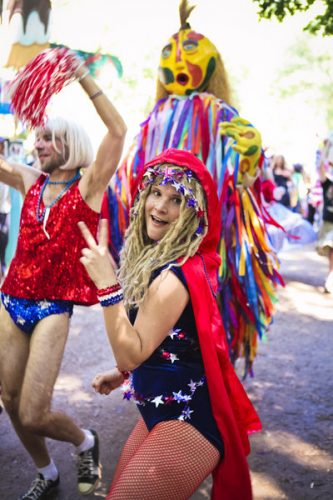
Grammar be damned; there’s no such thing as “the Fair.” “Are you going to Fair?” they’ll ask you, quite correctly. “Happy Fair!” you’ll hear and say innumerably. To the uninitiated, idiosyncrasy and eccentricity abound, but all are quick to adapt.
“The words can be kind of vague,” says Casey Marks-Fife, a Fair kitchen worker, with a mischievous chuckle as he demonstrates: “Everybody’s maxing. You find a place to max. Largely people will rally, and when they’re rallying, they’re just finding a place to max.”
Nothing can prepare you for something so random as a roving band of 25 people in pig costumes, beckoning you into their “oink circle.” Oregon Country Fair is all about human visual spectacle. Many come simply to people watch. Ozzy was right when he said, “Faeries wear boots, and you gotta believe me.” If you find anachronistic that bubbly gal with delicate, glittery wings and vixen black suede up to her thighs — relax. You’re thinking too hard.
Fairies, dragons and peaches play heavily into the iconography of Fair. The gate you walk into is a peach outline and the unofficial mascot of the event is Peachi the Dragon. The trope is derived from a locally held, peach-themed moku hanga — a piece of 18th-century Japanese woodblock art. Peachi roams the appropriately named “eight,” or main loop of the trail system, as a fabric-bodied apparition supported from beneath by parading fairgoers.
Parades exemplify the spontaneity of Fair, with onlookers bandwagoning at the drop of a hat. Flamingos flock and stilt-walkers tower over booth lines as they pass. Two daily marching bands are the only planned such excursions, while the rest is left to the imagination. On top of countless stage acts, there are “ambiance performers” such as mimes and “esoteric services” like Reiki healing, tarot reading and palm reading.
“Time is irrelevant,” Marks-Fife says. “If you say you want to be somewhere at a certain time, it’s a foregone conclusion that it’s not going to happen.” If you’re prone to gripping your calendar for a feeling of security, Fair won’t have it.
“This is a place for psycho-spiritual rejuvenation,” says Fair General Manager Charlie Ruff. “It’s not just about partying and having fun; it’s about the roots and the history and social responsibility.” Wisdom will find you through the “elders,” the venerable guiding spirits of Fair. To be an elder, one must be 55 years old, have participated in Fair in some capacity for 20 years and must relinquish any commerce role in the event.
“They keep the balance,” says Molly Ponkevich, a recent university graduate and fairgoer since the age of 13. “For me, seeing the roots is an ecstatic feeling. It’s cool to watch older performers strolling in their faerie costumes. There’s something so righteous in realizing 70-year-olds can get down too.”
If you end up having a great time, you have the “Fair family” to thank, because they’d rather not be called a staff. “Fair family is the people who come together to put the event on for the public,” says Lucy Kingsley of Fair’s board of directors. Everyone involved follows something called the “three chip interaction.”
“You: One, get the work done. Two, treat one another with love and respect. And three, have fun,” Kingsley says.
Home to quite the rumor mill, the staff after-party is apparently loads of fun, but nothing to fret over if you aren’t involved. There are plenty of campgrounds for non-staff, having just as ludicrous and beautiful a time. Passes and wristbands are not Willy Wonka’s golden tickets, but they can be serious work to attain. “It took me a lot of prying and looking to get one once I turned 18,” says Ponkevich, who networked hard to get onto the traffic crew.
Fair is about inclusion though. If you look at the origins of it, you can see the benign and nourishing philosophy of it all. “The baby boom generation that was coming of age in the late ’60s is responsible for getting the thing off the ground,” Ruff says. The younger generations now contribute their own unique fervor to the event, making it persevere, while bearing the unmistakable marks of influence from a counter-culture zenith only just downstream.